Salou, Tarragona, Spain – Wednesday, May 12th, 2010
“Lo siento, México y China son cerrados hasta el once, pero todo las atracciones en el ‘Far West’ esté abierto, como la ‘Stampida’, ‘Tomahawk’, y las atracciones acuáticas ‘Silver River ’ y ‘Grand Canyon’.”
Turning to me in a perplexed shock, the English gentleman asked, “Do you ‘ave any idea wut she just said?”
“Why yes, she said that Mexico and China are both closed until eleven, but the Far West area is open so we can do the Stampida or Tomahawk or the water rides.”
area is open so we can do the Stampida or Tomahawk or the water rides.”
Although a brief exchange, I cannot describe how pleasing it was for me to spontaneously act as an international translator. Mastery of foreign languages has never come natural to me, Spanish being the one subject in high school that gave me the most difficulties. Spring break in Cancun always seemed like a hellish endeavor anyway so I never imagined I would ever have any real-world use for the discipline. Thus during my European travels I assumed I’d always be the one needing to ask for an English translation, and certainly never be the one to provide it. To prove this wrong was a perfect way to start my day, even if it was at the expense of an expected morning marathon on Dragon Khan before the rest of the crowds arrived. (Although in all honesty, the only word of Spanish vocabulary I actually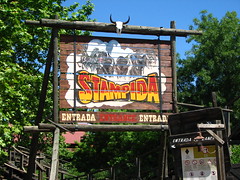 recognized was ‘once’, Spanish for eleven, and given the English names and circumstances it wasn’t hard to guess the rest.)
recognized was ‘once’, Spanish for eleven, and given the English names and circumstances it wasn’t hard to guess the rest.)
The day got even better when I was treated to no fewer than six rides on Stampida, twice on the blue (including the first front row ride of the day) then four circuits on the red, until it got to the point that crowds finally arrived in large enough numbers that I needed to think about preparing for my Dragon Khan dash in an hour. As they had no place to store loose items I was stuck carrying my camera along, so I figured as long as I had it in hand I might as well turn it on and get a POV (note this was from day 1):
Stampida is classic CCI. Which is to say there’s not much in the way of progression or unique sequencing patterns, but the experience has enough character and the layout is decently long enough such that it doesn’t particularly matter. Underbanked (or even unbanked) turns are ample, as are short transition lengths which produce the trademark CCI bite, notably on the few air hills where the train will hit the curve quite suddenly. Taken together with a racing dynamic featuring several lead changes and a point at which the tracks split only to later charge at each other moments later (this was the only genuine racing coaster CCI ever built), it could have been a real winner.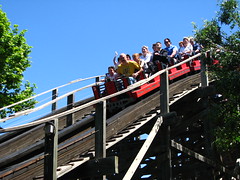
I hesitate slightly through using the auxiliary verb ‘could’ because my experience with Stampida was with a very slow ride. In fact, on the first morning ride in the front row, I literally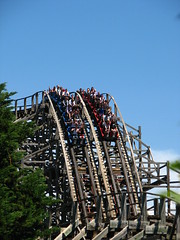 expected the train to rollback at the point where the tracks remerge after the split; we easily were going no faster than walking speed, and I understood why the attendants were only loading the front three or four cars for our morning cycles (although inexplicably they continued that practice for the rest of the operating day). This seems to be a common trait with many CCIs, where even good track maintenance and a smooth ride doesn’t prevent the trains from slumping around the final turns, but it was particularly bad in Stampida’s case. The presence of several magnetic trim brakes on the first drop certainly didn’t aid matters. I’m on the bench over whether the replacement of the original Philadelphia Toboggan Co. trains with prototype models from KumbaK was another detracting factor in the ride experience. It’s safe to say in the ideal world I would have preferred running with PTCs, but I don’t recall encountering any problems with the KumbaKs, no uncomfortable roughness save for some jackhammering just
expected the train to rollback at the point where the tracks remerge after the split; we easily were going no faster than walking speed, and I understood why the attendants were only loading the front three or four cars for our morning cycles (although inexplicably they continued that practice for the rest of the operating day). This seems to be a common trait with many CCIs, where even good track maintenance and a smooth ride doesn’t prevent the trains from slumping around the final turns, but it was particularly bad in Stampida’s case. The presence of several magnetic trim brakes on the first drop certainly didn’t aid matters. I’m on the bench over whether the replacement of the original Philadelphia Toboggan Co. trains with prototype models from KumbaK was another detracting factor in the ride experience. It’s safe to say in the ideal world I would have preferred running with PTCs, but I don’t recall encountering any problems with the KumbaKs, no uncomfortable roughness save for some jackhammering just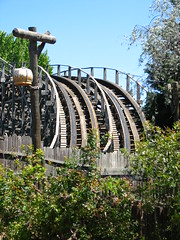 before the double up. For the most part I’d say the ride was simply moving too slowly in the second half to feel rough even if the track was in disrepair.
before the double up. For the most part I’d say the ride was simply moving too slowly in the second half to feel rough even if the track was in disrepair.
Highlights of the ride include the first swooping wave turns after the first drop, which remain at a constant flat bank despite the relatively high speeds and thus provide the strongest lateral forces, quite possibly in all of Spain. Immediately afterward a double up and double down sandwich a prototypical CCI elevated swoop turn, a nifty mirroring of a sequence that culminates into the best spot of airtime on the ride. And the dueling section, which is cleverly set up by using a tunnel to confuse riders at first from realizing the other track split from them; when they emerge, they find that two opposing tracks are present (the mystery third track belonging to Tomahawk) but their competing train has disappeared. When the other train comes barreling at them in apparently the wrong direction, it creates a moment of comic relief from the unexpected and rather absurd payoff. Evidenced by the fact that this is the place where everyone on board could be heard cheering the loudest, it might also be the only example I can think of in which a roller coaster uses its own language of expression to tell a ‘joke’. The ride finishes undramatically when the two tracks align once more, the effect supposing to be the final mad dash to the finish line,
roller coaster uses its own language of expression to tell a ‘joke’. The ride finishes undramatically when the two tracks align once more, the effect supposing to be the final mad dash to the finish line,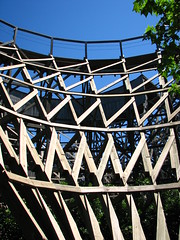 but by this point we’re going so slow that anyone concerning themselves with the outcome of the race will more likely be frustrated at the inability of either contestant to fight for the winning position.
but by this point we’re going so slow that anyone concerning themselves with the outcome of the race will more likely be frustrated at the inability of either contestant to fight for the winning position.
After a couple walk-on cycles on Tomahawk the hour was up and I joined the dash to Dragon Khan, would have been the first in line too if the opening of the Polynesia section hadn’t gotten there before the Old West. No matter; it was one train operation but for the first 45 minutes this proved sufficient to move crowds such that if you hurried you could make your way around the exit, back through the queue and into the station to get a lap on every other train. Repeat about eight times. My day was already much better than the previous.
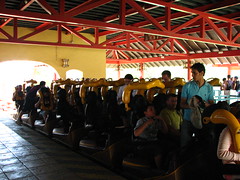 Completing a couple laps I noticed I seemed to get paired every cycle with two British pals who seemed to have the same idea as I. By the time this morning ride session had to wind down we parted ways for a half hour, only to shortly later randomly reconvene over at El Diablo. By this point it seemed that more formal introductions were needed. The pair reminded me somewhat of Nick Frost and Simon Pegg, and as the Nick Frost character explained they were on holiday in Spain after he was supposed to get married, but decided to ditch the would-be misses the night before the ceremony and go on his honeymoon with his best mate instead for as long as their money doesn’t run out. To this anecdote his ‘bride’ remained conspicuously silent, although the existence of a much more interesting story was no doubt just beneath the surface;
Completing a couple laps I noticed I seemed to get paired every cycle with two British pals who seemed to have the same idea as I. By the time this morning ride session had to wind down we parted ways for a half hour, only to shortly later randomly reconvene over at El Diablo. By this point it seemed that more formal introductions were needed. The pair reminded me somewhat of Nick Frost and Simon Pegg, and as the Nick Frost character explained they were on holiday in Spain after he was supposed to get married, but decided to ditch the would-be misses the night before the ceremony and go on his honeymoon with his best mate instead for as long as their money doesn’t run out. To this anecdote his ‘bride’ remained conspicuously silent, although the existence of a much more interesting story was no doubt just beneath the surface;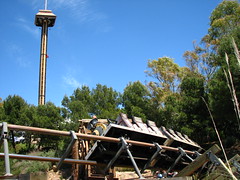 I decided it wise not to press further. In turn I shared my story, how I had been going to school in Rome for the past four months and was now spending my time in Spain until my summer study program in London started that Sunday.
I decided it wise not to press further. In turn I shared my story, how I had been going to school in Rome for the past four months and was now spending my time in Spain until my summer study program in London started that Sunday.
“That’s a good idea to spend your time here, just try to stay out of England for as long as you can until you absolutely have to go there. It’s about as much fun as AIDS.”
Advice to remember in a week’s time, I suppose. It seemed a mutual decision was made to next amble over to Hurakan Condor (an Intamin giant drop freefall tower some 300 feet tall). Good fortune continued to be with us as the hour-long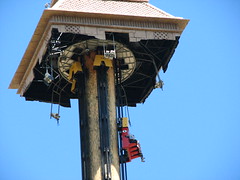 queue from yesterday had dissolved into barely a five minute wait today; plus there was a single rider line which would ensure walk-ons whenever I felt like it. While part of the short wait I’m sure was due to the operation of more sides of the tower than I saw yesterday, it also became clear that, for whatever unknown reason, Wednesday was simply not nearly as busy as Tuesday had been.
queue from yesterday had dissolved into barely a five minute wait today; plus there was a single rider line which would ensure walk-ons whenever I felt like it. While part of the short wait I’m sure was due to the operation of more sides of the tower than I saw yesterday, it also became clear that, for whatever unknown reason, Wednesday was simply not nearly as busy as Tuesday had been.
While waiting in queue we debated over which ‘version’ of the tower we would like to ride: standard sit down or floorless stand-up. At first the choice was suggested by my John Bull companions to go with the stand-up model until I observed the fast magnetic braking motion at the bottom combined with that seating design might cause a bit of a problem for male riders. “Ah, yeah, that gonna push ‘em back in, won’t it?” The choice ended up not being ours to make anyway, we were loaded in the next car available; I think the stand-up version.
I enjoyed Hurakan Condor a bit more than most other drop towers if only because of the extra height provided more pure free-fall. The absence of a giant ring in favor of the 4 abreast individual gondolas also probably cut back on the wind resistance somewhat compared to other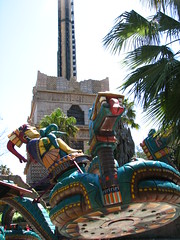 similarly scaled models. While there were some thematic structures at the base and top of the tower, these seemed to be for spectators only as they were mostly bare on the inside and contributed little to the ride experience.
similarly scaled models. While there were some thematic structures at the base and top of the tower, these seemed to be for spectators only as they were mostly bare on the inside and contributed little to the ride experience.
After a second ride we finally decided to part ways, this time for good. I needed to use the restroom anyway, so I located nearby a facility housed in a large Mayan pyramid. Afterward I went back to Hurakan Condor with plans to start a mini-marathon session using the single rider queue. Upon loading into the vehicle a ride attendant stopped me for “sus anteojos”, indicating my glasses. Oops, forgot they weren’t allowed on this cycle before I pulled my harness down; the attendant kindly took them for me and tucked them in a tight fabric bag near the platform. I went up, I came back down. Harnesses released I immediately went for my glasses so I could clearly see my way back out. Ah, that was fun I thought as I walked down the ramp and through the gift shop, the prospect of apparent unlimited rerides cause for a skip in my step. Today is turning out to be a very good day indeed.
I had spoken too soon. In an instant I realized something didn’t feel quite right. I had my glasses on, wallet and cellphone were still secure in my pockets… as I reached to check I realized I had two empty hands. Oh shit, my camera which I always keep the case looped between two of my fingers on my left hand I had forgotten to pick up. I quickly turned around and hurried back up to the exit platform, where the operators were working to dispatch another cycle. I caught the attention of one and asked if they had a camera left behind on the platform. They indicated I had remembered to pick up my anteojos.
“No… camera,” I repeated, hoping a Spanish accented inflection might help communicate my point while pantomiming taking a picture. She quickly looked back at the platform and asked a colleague. They agreed: eyeglasses, no camera.
As I wasn’t allowed back on the platform to check for myself I quickly hurried to try to retrace my steps, calming myself with assurance that in a minute or two my anxieties would surely be relieved. Did I set it down next to the sink or in the toilet stall and forget to pick it back up? I hurried back over to check, sure that was where I would find it… provided no one else did in the five minutes or so since I had left. It wasn’t there.
Promise of a happy ending feeling bleaker, I went back through the queue for Hurakan Condor, half-hoping to find it somewhere along the single rider line. Back on the platform I made a quick check of the floor nearby which I had set it down on my first rides. Nowhere. The ride was much harder to enjoy. My mind tumbled over my last steps. I couldn’t even remember how long I had been without it, what was the last picture I remember taking; it wasn’t back by El Diablo, was it? Regardless it was clear that even if I could remember exactly where I set it down, it hadn’t remained undisturbed in the time since. My only hope now was that an employee or charitable park guest had returned it to lost and found.
I submitted my report. It was a black Canon, I can’t remember the exact model name, but a bulkier point-and-shoot with a bigger lens. It belonged to my dad; he lent it to me so I could take better pictures for my time in Europe. I didn’t want to have to tell him he wouldn’t be seeing it again. They would check. I waited. They had nothing yet, but it was unlikely it would be turned in this quickly anyway. I should check back later that afternoon. By the way, my American accent is much easier to understand than the British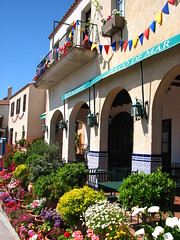 accents they always get. Umm, thanks. I’ll be back later.
accents they always get. Umm, thanks. I’ll be back later.
The rest of the day was a bit harder to enjoy, great photo opportunities seemingly around every corner, the impulse to reach for my camera halted only by the emptiness in my hand. What was I going to do if it’s not returned? Surely I was unlikely to see someone carrying it around the park, but that didn’t keep me from looking. My anxieties subdued somewhat after I remembered we had taken out insurance on it and would get a replacement in the event it was stolen, which I could easily bend my recollection of the events just enough to fit that narrative. That didn’t exactly help me right now, as I wondered whether I had gotten enough photos of Furius Baco or Hurakan Condor the previous day to satisfy the needs of this website. Nevertheless, lift must go on, and I still had coasters to ride.
Furius Baco was as rough as the previous day, though I was getting more used to where and how to ride it, and being better fed and watered that day meant I didn’t have to get a souvenir migraine to take away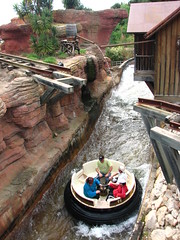 at the gift shop. Stampida was still only loading four of the six cars on either side, so I gave it a miss, having gotten my fill of rides in that morning, and cursed the fact I wouldn’t get a back seat ride to test if the first drop had particularly strong CCI whip. I contemplated trying the water rides but they appeared rather soaking and I wanted to stay warm. Eventually enough time had passed that I needed to return to lost and found. I walked in confident their afternoon lost-and-found collection at all of the rides would have found its way back here.
at the gift shop. Stampida was still only loading four of the six cars on either side, so I gave it a miss, having gotten my fill of rides in that morning, and cursed the fact I wouldn’t get a back seat ride to test if the first drop had particularly strong CCI whip. I contemplated trying the water rides but they appeared rather soaking and I wanted to stay warm. Eventually enough time had passed that I needed to return to lost and found. I walked in confident their afternoon lost-and-found collection at all of the rides would have found its way back here.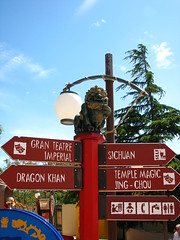
I walked out empty handed, with only a hollow suggestion to return one more time after park closing.
Needing a distraction and something else I could review, I caught a show at the Gran Teatro Imperial de China. Decent just for the spectacle, fairly impressive venue, though the division of the program into different sets each ‘inspired’ by one of the park’s various themed lands suggested the marketing department may have had a bit too much control over the script. The show also blew its wad too early, the first act consisting of Chinese acrobats flinging themselves through hoops of fire was by far everyone‘s favorite, such that for the following country and western musical number the applause that at its finale was noticeably of a lower decibel.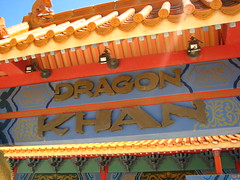
About an hour left to go before the day was over and most of the patrons had gone home, I made use of my time getting many more re-rides on Dragon Khan. Greater familiarity with coasters will almost inevitably breed greater appreciation, and that was certainly how I was feeling by the end of the trip. I had fairly high expectations for Dragon Khan to begin with, standing as the largest example along with Kumba from B&M’s early period, generally my most favored period of their work as their rides still felt the most organic (I would define ‘early work’ roughly as 1990 to 1995). It also remains their only project to date with eight inversions, making Dragon Khan a unique asset in the B&M canon. Yet somehow I couldn’t help but feel that warmth toward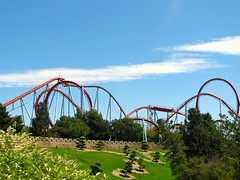 Dragon Khan was fundamentally tepid.
Dragon Khan was fundamentally tepid.
The inspiration to ‘one-up’ Kumba with an extra inversion seems rational, yet it came at the expense of most of the charms that ride had when it wasn’t turning you upside down. No tunnel into a helix finale, no chain lift threaded through the eye of a vertical loop, no little high-speed skip between the rolls barrel and cobra, no half-trenches dug around lush vegetation where the terrain seems contoured around the track. Just loop after loop after loop… after loop, over mostly flat terrain. This problem of low creativity with a predilection for plug-and-play element lineups and a disregard for dynamic pacing or progression would continuously plague rides from the Swiss duo for the decade to follow. That John Wardley had a hand in its design only a year after they collaborated on Nemesis makes this conclusion all the more disappointing. Its most uniquely defining feature I found besides the presence of an eighth inversion was the Mediterranean Sea visible from the top of the lift hill.
That John Wardley had a hand in its design only a year after they collaborated on Nemesis makes this conclusion all the more disappointing. Its most uniquely defining feature I found besides the presence of an eighth inversion was the Mediterranean Sea visible from the top of the lift hill.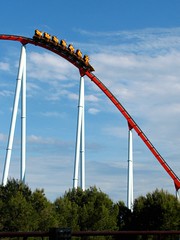
Cresting that lift a slow, flat turn anticipates the straight drop in a manner later employed on Wildfire. This drop is not as successful, taking a rather long time to get to maximum steepness which isn’t all that steep, only a scant whiff of full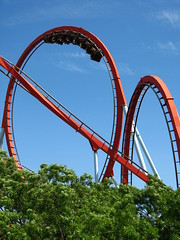 airtime available in the back of the shorter-than-usual 7-car train. Interestingly, if you want to maximize your uplift, you’re better off grabbing a seat in the right hand side. A slight counter-bank after the turn at the top ensures the right seats drops a little bit faster than the left while going down.
airtime available in the back of the shorter-than-usual 7-car train. Interestingly, if you want to maximize your uplift, you’re better off grabbing a seat in the right hand side. A slight counter-bank after the turn at the top ensures the right seats drops a little bit faster than the left while going down.
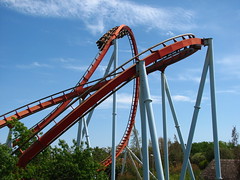 The vertical loop is a big vertical loop; the dive loop is a big dive loop. If you’ve been on either of these elements before you won’t find many surprises here as B&M recapitulate their standard opening act routine. The zero-g roll is the most intense part of the ride, a momentary increase in the rate of rotation around the heartline at the top of this maneuver causing a very noticeable ‘whip’. This could be endearing or annoying, depending on your point of view. The cobra roll finishes the opening sequence with another pair of fairly
The vertical loop is a big vertical loop; the dive loop is a big dive loop. If you’ve been on either of these elements before you won’t find many surprises here as B&M recapitulate their standard opening act routine. The zero-g roll is the most intense part of the ride, a momentary increase in the rate of rotation around the heartline at the top of this maneuver causing a very noticeable ‘whip’. This could be endearing or annoying, depending on your point of view. The cobra roll finishes the opening sequence with another pair of fairly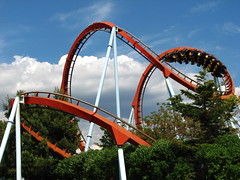 vanilla inversions, no pronounced snap at the top as found on many other early cobra rolls, a slight surprise given the exaggerated snap on the zero-g roll that immediately preceded it.
vanilla inversions, no pronounced snap at the top as found on many other early cobra rolls, a slight surprise given the exaggerated snap on the zero-g roll that immediately preceded it.
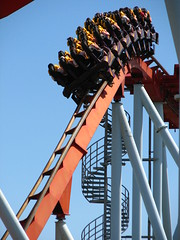 From here a somewhat awkward tilted rise into the midcourse block brake stands out as the first ‘element’ in the sequence which doesn’t result in turning one’s heels over head. It dives down into a small trench to set up the ‘extra’ inversion, a vertical loop. The centrifugal force
From here a somewhat awkward tilted rise into the midcourse block brake stands out as the first ‘element’ in the sequence which doesn’t result in turning one’s heels over head. It dives down into a small trench to set up the ‘extra’ inversion, a vertical loop. The centrifugal force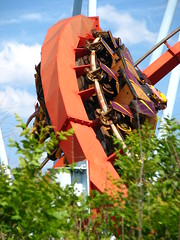 cancels out the gravitational pull back to earth such that it’s a fairly neutral element. I had to remind myself to notice it upon realizing after several rides I couldn’t specifically recall this inversion ever taking place. This pulls up into an inclined helix of sorts (so far the only bit of track I think B&M had to design wholly fresh from Kumba
cancels out the gravitational pull back to earth such that it’s a fairly neutral element. I had to remind myself to notice it upon realizing after several rides I couldn’t specifically recall this inversion ever taking place. This pulls up into an inclined helix of sorts (so far the only bit of track I think B&M had to design wholly fresh from Kumba 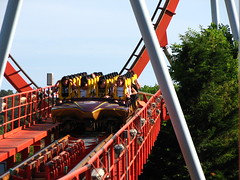 or other previous designs), which curls back down into the set of interlocking corkscrews, more succinct and aggressive than most of the layout that preceded it but nothing remarkable to anyone familiar with any of their other mega-looping coasters. And if you are familiar with their many, many mega-loopers, you’ll likely be trained to consider B&M’s corkscrews / flat spins as “the last inversions before the final whatever (normally helix)”. In this case, there is no finale to follow the corkscrews– that was your finale, the train only slithers around a tight left curve
or other previous designs), which curls back down into the set of interlocking corkscrews, more succinct and aggressive than most of the layout that preceded it but nothing remarkable to anyone familiar with any of their other mega-looping coasters. And if you are familiar with their many, many mega-loopers, you’ll likely be trained to consider B&M’s corkscrews / flat spins as “the last inversions before the final whatever (normally helix)”. In this case, there is no finale to follow the corkscrews– that was your finale, the train only slithers around a tight left curve where it abruptly levels out into the brakes.
where it abruptly levels out into the brakes.
Hmm, was that really eight loops just now? I lost count.
That all said, the unwavering persistent beat of ‘loop-loop-loop-loop-loop’ has an appeal to it I suspect is similar to the appeal of electronic dance music. I personally don’t care for the style but that doesn’t mean others might not. The eight inversions even form a complete octave… okay that’s really stretching the musical comparison but I wanted to throw it out there anyway. I would still like to ask, what harm would a bit more progression and variation in rhythm really present to fans of the ride? Looking through polls and other reviews it seems to still be the more favored ride over countryman Superman: La Atracción de Acero, although I will confess I preferred that one’s floorless design, steeper, more direct first drop and absence of any midcourse pause over Dragon Khan.
be the more favored ride over countryman Superman: La Atracción de Acero, although I will confess I preferred that one’s floorless design, steeper, more direct first drop and absence of any midcourse pause over Dragon Khan.
All good things must come to an end, and eventually on one of my sprints down the exit ramp and back to the entry pagoda I found my path blocked by linked chain. I had been adequately distracted from the situation which haunted me the better part of the day, and now as approached once more the guest services office I had one last chance for a happy resolution to my day. Would luck and good karma ultimately prevail?
An hour later I was boarding my train to Barcelona, empty handed.
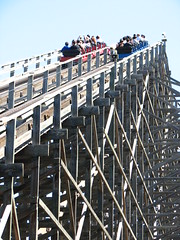
Comments